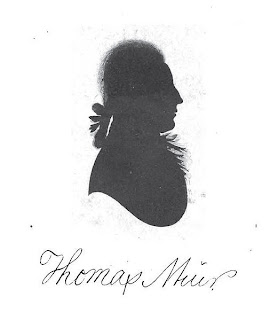Basil William Douglas-Hamilton, Lord Daer (1764-1794) was far from a typical Scottish aristocrat. Whilst in France in 1789 he was deeply impressed and inspired by the revolutionaries; on his return to Scotland took up the radical cause. Daer joined the corresponding societies then advocating radical political reform and became an important figure in the movement before his early death of tuberculosis. The following lines were written in his honour by his fellow radical Robert Burns:
Then from his Lordship I shall learn,
Henceforth to meet with unconcern
One rank as weel's another;
Nae honest, worthy man need care
To meet with noble youthful Daer,
For he but meets a brother.
The following obituary appeared in the Gentleman’s Magazine, May, 1795.
'Lord Daer, died of a consumption; at Ivy-Bridge, Devon; and was buried at Exeter. To those unacquainted with his Lordship, it is not easy to convey an adequate idea of his character. Though heir-apparent of a princely fortune, he had never listened to the siren voice, nor tasted the intoxicating cup, of Pleasure. His active mind, eagerly engaged in the pursuits of business, submitted with impatience to that repose which was necessary to preserve its vigour. Nothing could equal the felicity with which he conceived the ardour with which he pursued, and the judgment he displayed in accomplishing, the multifarious objects which occupied his attention, Of every subject which had fallen under his notice he had a complete and thorough acquaintance; and, as the sphere of his observation was enlarged, his knowledge was not only accurate but extensive. In that public business, which more immediately concerned the two counties in which his father’s estate was situated, his Lordship had a large and important share. His zeal and fidelity in the discharge of every public duty secured the esteem and approbation of all. In tracing out the line of’ a. new road, or improving the direction of an old one, the ability of his Lordship was unrivaled. Of his superiority in this respect, the counties of Wigtown and Kirkcudbright afford many decisive monuments.
Disinterested and patriotic, his sacrifices to public convenience were worthy of public gratitude. He spared not his choicest fields when a road could be improved by traversing them. Of almost every institution formed to extend the limits of human knowledge, or to promote the interests of mankind, his Lordship was a member; and to every public undertaking his subscriptions were liberal and exemplary. Over his political character, while the minds of men are heated by party spirit, it may be proper to throw a veil. Though his prudence was justly called in question, yet the purity of his intentions was superior to suspicion. In every enterprize he embarked with invincible zeal; and when the object was inexpedient, it was some time before he could discover his mistake. As a public speaker, his matter was judicious, his meth6d conspicuous, and his manner insinuating and persuasive. Though you were not dazzled by the splendour of his eloquence, you were convinced by the masculine strength of his arguments, and the clearness with which he treated his subject. In his intercourse with the world he was modest, courteous, and easy. He could descend from the dignity of his rank, without impairing the dignity of his character. In every social and domestic relation, his private virtues shone with a mild and attractive lustre. Nothing could discompose the tranquillity of his temper, or sour the natural sweetness of his manners. A correspondent says he has reason to believe that the late Lord Daer broke off all connexion with the men he had formerly acted with, as soon as he discovered their motives to be less pure and patriotic that his own; and that, for some time before his death, he had renounced all communication with Democrats. How glorious it would be for men, who act from principles thus to abjure their errors as soon as discovered, and not continue a mischievous connexion through false pride and shame.'
The Gentleman’s Magazine for Nov. 1794 had contained the following short notice of Lord Daer’s death:
Lately on his way to the island of Madeira for the recovery of his health, in the 29th year of his age, Basil William Lord Daer, eldest son of the Earl of Selkirk, and late a member of the Edinburgh Convention.


















